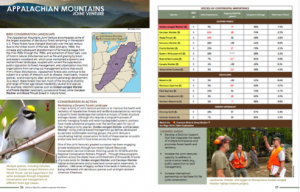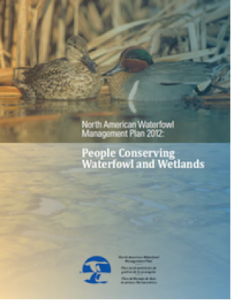The AMJV was founded to coordinate and implement all national bird conservation plans within the Appalachian Mountains Bird Conservation Region. Our regional partnership guides member organizations to meet objectives established by state, national, and international bird conservation plans as well as to coordinate landscape-level conservation efforts for native birds and their habitats.
The AMJV staff works with each of the national bird plan partnerships and the AMJV Technical Committee to identify priority species (link) for the AMJV and their associated habitat needs. Collectively, we achieve positive outcomes for bird populations by coordinating programmatic strengths, enhancing capacity, and implementing projects at the regional scale.
The AMJV works with the North American Bird Conservation Initiative (NABCI), which synthesizes the various Bird Conservation Plan goals and objectives across North America to promote and advance integrated bird conservation. The U.S. Committee of NABCI helps partners meet their common bird objectives by fostering coordination and collaboration on key issues of concern such as conservation on private lands, conservation design, and international collaboration.
 The majority of the AMJV’s priority species are landbirds, so much of our work is guided by Partners in Flight (PIF) and the 2016 Landbird Conservation Plan. The mission of PIF is to keep common birds common and help species at risk through voluntary partnerships. The focus of the 2016 plan was to present the results of a comprehensive landbird species vulnerability assessment at the national scale and to provide recommendations to advance high priority landbird conservation actions over the next 10 years. Both national and regional vulnerability assessment scores are available for all bird species through the Avian Conservation Assessment Database.
The majority of the AMJV’s priority species are landbirds, so much of our work is guided by Partners in Flight (PIF) and the 2016 Landbird Conservation Plan. The mission of PIF is to keep common birds common and help species at risk through voluntary partnerships. The focus of the 2016 plan was to present the results of a comprehensive landbird species vulnerability assessment at the national scale and to provide recommendations to advance high priority landbird conservation actions over the next 10 years. Both national and regional vulnerability assessment scores are available for all bird species through the Avian Conservation Assessment Database.
 The 2012 North American Waterfowl Management Plan (NAWMP) details the goal of creating conditions for abundant and resilient waterfowl populations and sustainable landscapes through management decisions based on strong biological foundations. The Plan is international in scope, while implementation functions at the regional, bird habitat Joint Venture level. Since its inception, NAWMP partners have conserved and restored million acres of wetlands and grasslands and other key habitats for ducks, geese, and swans. For more information, visit the NAWMP website.
The 2012 North American Waterfowl Management Plan (NAWMP) details the goal of creating conditions for abundant and resilient waterfowl populations and sustainable landscapes through management decisions based on strong biological foundations. The Plan is international in scope, while implementation functions at the regional, bird habitat Joint Venture level. Since its inception, NAWMP partners have conserved and restored million acres of wetlands and grasslands and other key habitats for ducks, geese, and swans. For more information, visit the NAWMP website.
 The U.S. Shorebird Conservation Partnership Conservation Plan, completed in 2000, is a scientific framework that determines species, sites, and habitats that most urgently need action to maintain populations of migratory shorebirds. The plan provides an overview of the current status of shorebirds, conservation challenges facing them, opportunities for integrating conservation, and specific programs necessary to meet the overall vision of restoring stable and self-sustaining populations. In 2016, the Partnership produced an updated list of Shorebirds of Conservation Concern for the U.S.
The U.S. Shorebird Conservation Partnership Conservation Plan, completed in 2000, is a scientific framework that determines species, sites, and habitats that most urgently need action to maintain populations of migratory shorebirds. The plan provides an overview of the current status of shorebirds, conservation challenges facing them, opportunities for integrating conservation, and specific programs necessary to meet the overall vision of restoring stable and self-sustaining populations. In 2016, the Partnership produced an updated list of Shorebirds of Conservation Concern for the U.S.
 The Waterbird Conservation for the Americas Plan was completed in 2002 to support a vision in which the distribution, diversity, and abundance of populations and habitats of breeding, migratory, and nonbreeding waterbirds are sustained or restored throughout the lands and waters of North America, Central America, and the Caribbean. It advocates continent-wide monitoring; provides an impetus for regional conservation planning; proposes national, state, provincial and other local conservation planning and action; and gives a larger context for local habitat protection.
The Waterbird Conservation for the Americas Plan was completed in 2002 to support a vision in which the distribution, diversity, and abundance of populations and habitats of breeding, migratory, and nonbreeding waterbirds are sustained or restored throughout the lands and waters of North America, Central America, and the Caribbean. It advocates continent-wide monitoring; provides an impetus for regional conservation planning; proposes national, state, provincial and other local conservation planning and action; and gives a larger context for local habitat protection.
 Congress charged each state with developing proactive State Wildlife Action Plan that regularly assess the health of each state's wildlife and habitats, identify environmental problems, and outline actions needed to conserve wildlife for the long term. Within each State Wildlife Action Plan are clear and compelling conservation goals to restore unique habitats and keep rare and imperiled species off of endangered listing as well as defined measures of success to recover endangered species. The AMJV works with each state to keep their individual efforts within a regional context and foster collaborations across state boundaries.
Congress charged each state with developing proactive State Wildlife Action Plan that regularly assess the health of each state's wildlife and habitats, identify environmental problems, and outline actions needed to conserve wildlife for the long term. Within each State Wildlife Action Plan are clear and compelling conservation goals to restore unique habitats and keep rare and imperiled species off of endangered listing as well as defined measures of success to recover endangered species. The AMJV works with each state to keep their individual efforts within a regional context and foster collaborations across state boundaries.
Click here to view and download the 2023 AMJV Partnership Year in Review!
Read MoreThe 2023 AMJV Impact Report is now available for downloading and sharing! Starting in 2022, this beautiful report has been designed annually by Liz Brewer (AMJV Outreach Specialist) to…
Read Moreby Liz Brewer, AMJV Outreach Specialist Appalachian Mountains Joint Venture (AMJV), in partnership with the National Wild Turkey Federation (NWTF), USDA Natural Resources Conservation Service (USDA-NRCS), and the West Virginia…
Read MoreAppalachian Mountains Joint Venture
1700 Kraft Drive, Suite 1375
Blacksburg, VA 24060
Office: (540) 951-9376
© 2019 Appalachian Mountains Joint Venture Funded by: AMJV Partners Website by Skyhound Internet
